| |
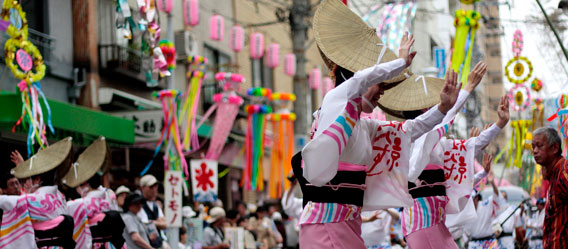
The Tanabata festival is traditionally celebrated each year on the 7th day of the 7th month of the Japanese lunisolar calendar. Today, the festival may be held on July 7th or in some regions in Japan on days close to August 7th, or in accordance with the traditional lunisolar calendar.
Also known as the star festival, this festival originated in China, known as the Qixi festival, which celebrates the meeting and reunion of the deities Orihime (known in Chinese legends as Zhinu—weaver girl) and Hikoboshi (known in Chinese legends as Niulang—cowherd) once every year.
Mythology
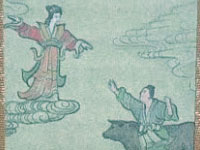 The festival was inspired by the Chinese myth of the “Weaver and the Cowherd” which tells of the story of the weaver girl (symbolizing the star Vega), a celestial being and the daughter of a goddess who escaped from heaven into the mortal realm to have fun. While on earth, the weaver girl met the cowherd (symbolizing the star Altair), a mortal man, and they fell in love. They married and started a family without the knowledge and approval of the mother goddess of heaven. The weaver girl and the cowherd were a loving couple and had two children, but their happiness was short-lived. When the mother goddess of heaven found out that the weaver girl had escaped to earth and married a mortal she was angered by the forbidden romance and the realization that the weaver girl had neglected her celestial duties to weave colorful clouds in the sky. The festival was inspired by the Chinese myth of the “Weaver and the Cowherd” which tells of the story of the weaver girl (symbolizing the star Vega), a celestial being and the daughter of a goddess who escaped from heaven into the mortal realm to have fun. While on earth, the weaver girl met the cowherd (symbolizing the star Altair), a mortal man, and they fell in love. They married and started a family without the knowledge and approval of the mother goddess of heaven. The weaver girl and the cowherd were a loving couple and had two children, but their happiness was short-lived. When the mother goddess of heaven found out that the weaver girl had escaped to earth and married a mortal she was angered by the forbidden romance and the realization that the weaver girl had neglected her celestial duties to weave colorful clouds in the sky.
She thus forcibly removed weaver girl from the cowherd and the children. Heartbroken at the disappearance of his wife, the cowherd and the children searched for the weaver girl. The ox of the cowherd revealed to the cowherd that if he killed him and wore his hide, he would be able to go up to heaven to look for his wife. Thus, tearfully, the cowherd killed his ox and put on his hide, and carrying his two children they ascended to heaven to look for the weaver girl. When the goddess of the heaven found out about this, she was again greatly angered and with her hairpin, scratched a wide celestial river (symbolizing the milky way) between cowherd and the weaver girl.
Separately by the river, the weaver girl sadly gazed at the cowherd and her children from her loom, while the cowherd watches her from across the river raising the children. But once every year, the magpies of the world, taking pity on them would form a bridge—the bridge of the magpies—so that the lovers and the family may reunite on the seventh day of the seventh month, celebrated in the Tanabata festival. In Japan, it is believed that if it rains on the day of the tanabata, the couple will not be able to see each other and must wait another year before they can be reunited, so people pray for good weather and makes wishes for themselves.
Customs and Celebration
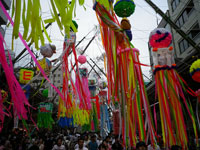 In Japan, the tanabata festival has been celebrated since its importation in 755 A.D. by the Empress Koken. By the Edo period, tanabata is widely celebrated all across Japan although regional variations in traditions and customs exist. Traditionally, during the tanabata festival, girls wished for better sewing and craftsmanship skills, while boys wished for better handwriting. Their wishes are written on strips of papers. This custom is continued today, in celebration of the festival, people in Japan generally write short poetries on small pieces of paper and hang them on a bamboo wish tree. The bamboo tree along with the decorations and the wishes are then set afloat on a river or burned after the festival. In Japan, the tanabata festival has been celebrated since its importation in 755 A.D. by the Empress Koken. By the Edo period, tanabata is widely celebrated all across Japan although regional variations in traditions and customs exist. Traditionally, during the tanabata festival, girls wished for better sewing and craftsmanship skills, while boys wished for better handwriting. Their wishes are written on strips of papers. This custom is continued today, in celebration of the festival, people in Japan generally write short poetries on small pieces of paper and hang them on a bamboo wish tree. The bamboo tree along with the decorations and the wishes are then set afloat on a river or burned after the festival.
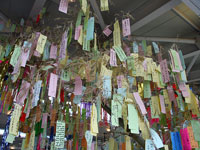 In celebration of tanabata, street festivals along shopping malls and streets are a common sight. Colorful streamers add festivities and decorate these tanabata festivals. Many regional variations exist in tanabata festival celebrations, but common festival activities include decoration competitions, parades, Miss Tanabata pageants, outdoor stalls selling street food, and carnival games. In celebration of tanabata, street festivals along shopping malls and streets are a common sight. Colorful streamers add festivities and decorate these tanabata festivals. Many regional variations exist in tanabata festival celebrations, but common festival activities include decoration competitions, parades, Miss Tanabata pageants, outdoor stalls selling street food, and carnival games.
In some Japanese regions, lighted lanterns are set afloat down rivers and sometimes bamboo leaves are floated downstream.
The cities of Sendai and Hiratsuka are the most famous for their elaborate tanabata celebrations. In Hiratsuka, the festival is held for several days and is well known for their amazing decorative displays.
Even Disneyland in Japan celebrates tanabata. The Tokyo Disneyland celebrates the festival by a greeting parade with Mickey as Hikoboshi (cowherd) and Minnie as Orihime (weaver girl). Other cast members dressed in festive yukata hand out pieces of papers in the shape of Mickey Mouse for the audience members to write down their wishes that they can tie their wishes on stands provided.
Festival Food
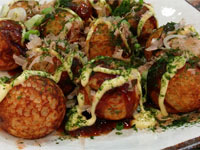 Popular festival street food is often found in tanabata festivals. Small stalls selling dango mochi balls—sweet chewy Japanese dessert that often feature red bean paste fillings—are commonly found. Other popular street food items such as takoyaki octopus balls and yakisoba—a fried noodle dish with cabbage and pork topped with yakisoba sauce and Japanese mayonnaise are favorites. Taiyaki, a fish-shaped Japanese cake featuring red bean, chocolate, cream cheese, or other fillings, yakitori grills of chicken and meat on skewers, okonomiyaki, a form of savory Japanese pancake made with batter and features ingredients such as cabbage, spring onion, meat, and seafood, and the best of Japanese yaki cooking can be found at most festival food stalls. Popular festival street food is often found in tanabata festivals. Small stalls selling dango mochi balls—sweet chewy Japanese dessert that often feature red bean paste fillings—are commonly found. Other popular street food items such as takoyaki octopus balls and yakisoba—a fried noodle dish with cabbage and pork topped with yakisoba sauce and Japanese mayonnaise are favorites. Taiyaki, a fish-shaped Japanese cake featuring red bean, chocolate, cream cheese, or other fillings, yakitori grills of chicken and meat on skewers, okonomiyaki, a form of savory Japanese pancake made with batter and features ingredients such as cabbage, spring onion, meat, and seafood, and the best of Japanese yaki cooking can be found at most festival food stalls.
Stars and Tanabata
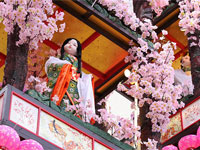 The tanabata festival, also known as the star festival celebrates the love of the mythological figures of the cowherd and the weaver girl, representatives of the Altair and Vega stars. It celebrates their annual reunion that joins them across the milkyway. A romantic myth that may have given meaning to the stars in the sky observed by people in ancient times, but the story is no less moving for today’s generation, and the celebration of the tanabata festival continues to give meaning and celebration to this love story. The tanabata festival, also known as the star festival celebrates the love of the mythological figures of the cowherd and the weaver girl, representatives of the Altair and Vega stars. It celebrates their annual reunion that joins them across the milkyway. A romantic myth that may have given meaning to the stars in the sky observed by people in ancient times, but the story is no less moving for today’s generation, and the celebration of the tanabata festival continues to give meaning and celebration to this love story.
|
|
 |
OUR 2014 NEWSLETTERS
Tanabata Festival: Reunion of deities and making of wishes
Onigiri—Japanese Rice Balls: Traditional Convenience Food
Owls in Japan—Symbolism and Myth
Takoyaki: The street food at the Crossroad of history
White Day: The Reverse Valentine’s Day
Chinese New Year: Flowers of Celebration
Chinese Hot Pot: Gathering around Cooking
NEWSLETTER ARCHIVES
2014
2013
2012
2011
2010
2009
2008
2007
2006
2005
2004
2003
2002
2001
|


 The festival was inspired by the Chinese myth of the “Weaver and the Cowherd” which tells of the story of the weaver girl (symbolizing the star Vega), a celestial being and the daughter of a goddess who escaped from heaven into the mortal realm to have fun. While on earth, the weaver girl met the cowherd (symbolizing the star Altair), a mortal man, and they fell in love. They married and started a family without the knowledge and approval of the mother goddess of heaven. The weaver girl and the cowherd were a loving couple and had two children, but their happiness was short-lived. When the mother goddess of heaven found out that the weaver girl had escaped to earth and married a mortal she was angered by the forbidden romance and the realization that the weaver girl had neglected her celestial duties to weave colorful clouds in the sky.
The festival was inspired by the Chinese myth of the “Weaver and the Cowherd” which tells of the story of the weaver girl (symbolizing the star Vega), a celestial being and the daughter of a goddess who escaped from heaven into the mortal realm to have fun. While on earth, the weaver girl met the cowherd (symbolizing the star Altair), a mortal man, and they fell in love. They married and started a family without the knowledge and approval of the mother goddess of heaven. The weaver girl and the cowherd were a loving couple and had two children, but their happiness was short-lived. When the mother goddess of heaven found out that the weaver girl had escaped to earth and married a mortal she was angered by the forbidden romance and the realization that the weaver girl had neglected her celestial duties to weave colorful clouds in the sky.  In Japan, the tanabata festival has been celebrated since its importation in 755 A.D. by the Empress Koken. By the Edo period, tanabata is widely celebrated all across Japan although regional variations in traditions and customs exist. Traditionally, during the tanabata festival, girls wished for better sewing and craftsmanship skills, while boys wished for better handwriting. Their wishes are written on strips of papers. This custom is continued today, in celebration of the festival, people in Japan generally write short poetries on small pieces of paper and hang them on a bamboo wish tree. The
In Japan, the tanabata festival has been celebrated since its importation in 755 A.D. by the Empress Koken. By the Edo period, tanabata is widely celebrated all across Japan although regional variations in traditions and customs exist. Traditionally, during the tanabata festival, girls wished for better sewing and craftsmanship skills, while boys wished for better handwriting. Their wishes are written on strips of papers. This custom is continued today, in celebration of the festival, people in Japan generally write short poetries on small pieces of paper and hang them on a bamboo wish tree. The  In celebration of tanabata, street festivals along shopping malls and streets are a common sight. Colorful streamers add festivities and decorate these tanabata festivals. Many regional variations exist in tanabata festival celebrations, but common festival activities include decoration competitions, parades, Miss Tanabata pageants, outdoor stalls selling street food, and carnival games.
In celebration of tanabata, street festivals along shopping malls and streets are a common sight. Colorful streamers add festivities and decorate these tanabata festivals. Many regional variations exist in tanabata festival celebrations, but common festival activities include decoration competitions, parades, Miss Tanabata pageants, outdoor stalls selling street food, and carnival games. Popular festival street food is often found in tanabata festivals. Small stalls selling dango mochi balls—sweet chewy Japanese dessert that often feature red bean paste fillings—are commonly found. Other popular street food items such as
Popular festival street food is often found in tanabata festivals. Small stalls selling dango mochi balls—sweet chewy Japanese dessert that often feature red bean paste fillings—are commonly found. Other popular street food items such as  The tanabata festival, also known as the star festival celebrates the love of the mythological figures of the cowherd and the weaver girl, representatives of the Altair and Vega stars. It celebrates their annual reunion that joins them across the milkyway. A romantic myth that may have given meaning to the stars in the sky observed by people in ancient times, but the story is no less moving for today’s generation, and the celebration of the tanabata festival continues to give meaning and celebration to this love story.
The tanabata festival, also known as the star festival celebrates the love of the mythological figures of the cowherd and the weaver girl, representatives of the Altair and Vega stars. It celebrates their annual reunion that joins them across the milkyway. A romantic myth that may have given meaning to the stars in the sky observed by people in ancient times, but the story is no less moving for today’s generation, and the celebration of the tanabata festival continues to give meaning and celebration to this love story. 